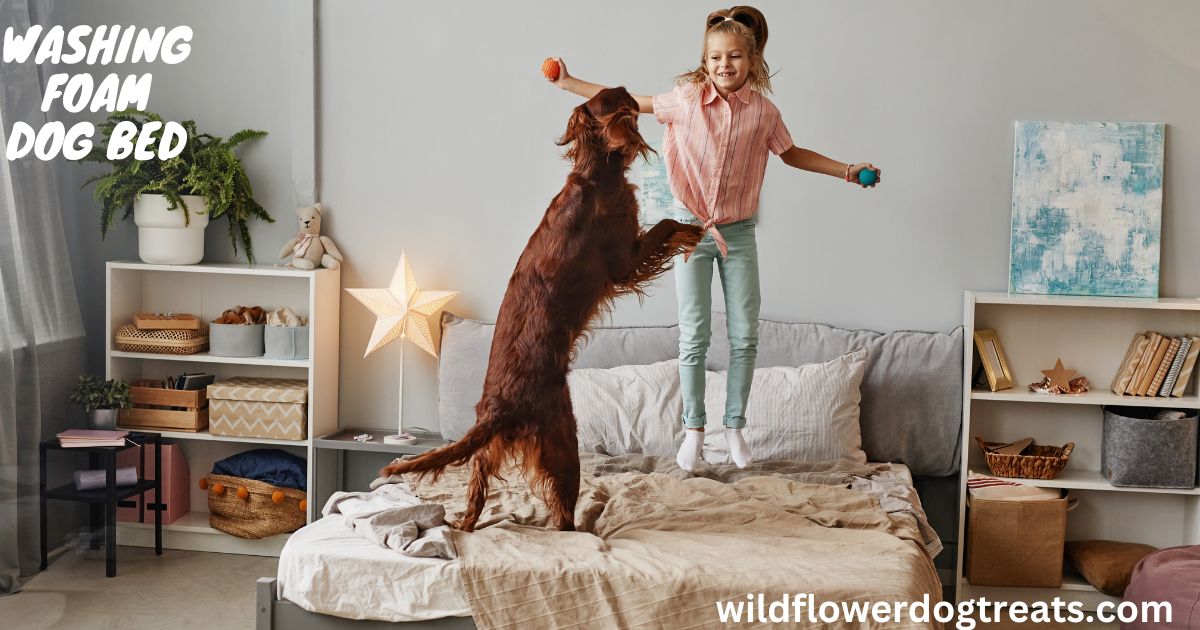If your dog can’t jump onto the bed, it may be due to age, health issues, or lack of training. dog unable to jump onto bed. Addressing these factors will help your dog regain the ability to jump and improve their overall mobility.
Additionally, using a ramp or steps can provide a safe and convenient way for your dog to access the bed. Regular exercise and a balanced diet will also support your dog’s physical health and strength, making it easier for them to jump onto the bed.
Taking proactive steps to assist your dog with this issue will ensure their comfort and well-being. With the right approach, your dog will be back to enjoying cuddles on the bed in no time.
Realizing The Importance Of Providing Access
As pet owners, it’s important to realize that our dogs, regardless of their breed or size, have unique needs and limitations. One common challenge faced by many dog owners is the inability of their furry companions to easily jump onto the bed. This seemingly small issue can have a significant impact on the well-being of your pet. Fortunately, by understanding the importance of providing access, we can address this concern and ensure our dogs enjoy a comfortable and accessible living environment.
Importance Of A Comfortable Sleeping Area
Proper and comfortable sleeping arrangements are crucial for the overall well-being of your dog. Access to a comfortable sleeping area, such as your bed, allows your pet to feel secure, loved, and part of the family. By not being able to join you on the bed, your furry friend may feel isolated, leading to anxiety and stress. By providing access to the bed and other comfortable sleeping areas, you are fostering a sense of belonging and comfort in your pet’s life.
Impact Of Limited Mobility On Your Dog’s Well-being
When a dog is unable to jump onto the bed due to limited mobility, it can have various negative impacts on their physical and emotional well-being. Apart from feeling left out, your pet may miss out on the warmth and security that comes with snuggling up on the bed. Additionally, limited access to elevated areas may result in joint stiffness and muscle atrophy, both of which can lead to health issues and diminished quality of life for your beloved pet.
Evaluating Age And Size Factors
Understanding How Age Affects Mobility
Age plays a crucial role in a dog’s ability to jump onto a bed. As dogs age, they may experience a decline in mobility and strength, making it more challenging for them to perform physical activities such as jumping. Joint stiffness, muscle atrophy, and reduced flexibility are common age-related factors that can affect a dog’s jumping ability. Older dogs may also be more prone to health conditions such as arthritis, which can further impede their mobility. It’s important for pet owners to consider their dog’s age when assessing the reasons behind their inability to jump onto the bed.
Considering The Impact Of Size On Jumping Ability
The size of a dog can significantly influence its jumping ability. Smaller breeds may find it easier to jump onto a bed due to their lighter weight and agility, while larger breeds may struggle due to their size and weight. Factors such as body structure and muscle strength play a role in a dog’s capacity to execute a successful jump. Additionally, breed-specific characteristics can also impact jumping ability, with some breeds naturally excelling in agility and athleticism compared to others. Understanding the impact of size on a dog’s jumping ability is essential for determining the underlying reasons behind their inability to access elevated surfaces.
Assessing Health Issues And Physical Limitations
Assessing the ability of your dog to jump onto the bed is crucial for understanding their health and physical limitations. Recognizing potential health conditions and addressing musculoskeletal limitations are essential steps in ensuring your furry friend’s well-being.
Recognizing Potential Health Conditions
Dogs that struggle to jump onto the bed may have underlying health issues that need attention. It’s important to keep an eye out for signs of pain or discomfort, which could indicate conditions such as arthritis, joint problems, muscle weakness, or injuries. A visit to the veterinarian can help identify any health issues and provide the necessary treatment and management.
Addressing Musculoskeletal Limitations
Understanding your dog’s musculoskeletal limitations is crucial in ensuring their comfort and mobility. Certain breeds are prone to musculoskeletal issues, and as they age, they may experience a decline in their jumping ability. Providing supportive resources such as ramps or steps can help them access the bed without strain. Additionally, implementing a balanced diet and regular exercise can help maintain their muscle strength and joint health.
Strategic Bed Placement And Modifications
Dogs are known for their loyalty and affection, often wanting to be as close as possible to their human companions. However, not all dogs are able to jump onto the bed due to various reasons such as age, size, or physical limitations. In such cases, strategic bed placement and modifications can make a significant difference, ensuring that your furry friend can still enjoy the comfort of sleeping close to you without any difficulty.
Creating Lower Access Points To The Bed
One of the easiest ways to address the issue of a dog being unable to jump onto the bed is by creating lower access points. This can be achieved by placing a sturdy ottoman or a bench at the foot of the bed, allowing the dog to use it as a step to climb on. Ensuring that the height of the access point matches the capabilities of the dog is crucial to prevent any accidents or injuries.
Utilizing Step Stools And Ramps
For dogs with more pronounced difficulty in reaching the bed, using specially designed step stools or ramps can be incredibly beneficial. These tools provide a gradual and stable incline, allowing the dog to ascend easily without exerting excessive effort. The key is to choose a step stool or ramp that is sturdy, non-slip, and appropriate for the dog’s size and weight.
Exercise And Mobility Improvement Techniques
Exercise and mobility improvement techniques are essential for helping your dog overcome the challenge of not being able to jump onto the bed. By incorporating regular exercise routines and exploring strength and flexibility training, you can assist your furry friend in enhancing their agility and overall mobility. In this section, we will delve into these techniques, offering practical solutions to address this common issue.
Incorporating Regular Exercise Routines
Regular exercise is crucial for maintaining your dog’s physical fitness and promoting overall mobility. Engaging in consistent physical activity can help strengthen muscles, improve coordination, and enhance cardiovascular health. Here are some exercises that can effectively support your dog’s mobility:
- Walking: Regular walks help improve muscle tone and joint flexibility.
- Swimming: Swimming is an excellent low-impact exercise that promotes muscle strength and flexibility.
- Obstacle Courses: Designing simple obstacle courses can stimulate agility and coordination.
Exploring Strength And Flexibility Training
Strength and flexibility training play a vital role in improving your dog’s ability to jump onto the bed. Focusing on exercises that target specific muscle groups and enhance flexibility can greatly benefit your pet’s mobility. Here are some effective strength and flexibility training techniques:
- Balance Exercises: Balancing activities help improve stability and coordination.
- Core Strengthening: Core-specific exercises can enhance abdominal and back muscle strength.
- Stretching: Incorporating regular stretching routines helps maintain muscle flexibility and joint mobility.
Seeking Professional Guidance And Support
When your dog is unable to jump onto the bed, seeking professional guidance and support can be the key to addressing the issue effectively. Whether it’s a physical limitation or a behavioral challenge, consulting a veterinarian or animal behaviorist and exploring the potential use of assistive devices can provide valuable insights and solutions.
Consulting A Veterinarian Or Animal Behaviorist
If your dog is experiencing difficulty jumping onto the bed, consulting with a veterinarian or animal behaviorist is crucial. These professionals can conduct a thorough assessment to determine if there are any underlying medical or behavioral issues contributing to the problem. A veterinarian can rule out any physical ailments that could be causing pain or discomfort, while an animal behaviorist can offer expertise in understanding and modifying your dog’s behavior.
Potential Use Of Assistive Devices
Exploring the potential use of assistive devices can provide your dog with the support they need to access the bed comfortably. This can include ramps or steps designed specifically for pets, which can help bridge the gap between the floor and the bed. By incorporating these devices into your dog’s environment, you can enable them to navigate their surroundings more easily and prevent potential strain or injury from jumping.
Establishing A Comforting And Loving Atmosphere
When your dog can’t jump onto the bed, it’s crucial to establish a comforting and loving atmosphere to ensure they feel safe and supported. Providing emotional and physical support and promoting bonding and trust building are essential for creating a nurturing environment for your furry friend.
Providing Emotional And Physical Support
Dogs can feel anxious and frustrated when they are unable to access the bed, which can impact their overall well-being. It is important to provide emotional support by reassuring your dog through gentle and affectionate interactions. Additionally, offering physical support such as using pet stairs or a ramp can help your dog comfortably access the bed without fear or strain.
Promoting Bonding And Trust Building
Promoting bonding and trust building with your dog is crucial for creating a harmonious living environment. Engage in positive reinforcement training sessions to encourage your dog to approach the bed with confidence. Spend quality time engaging in playful activities and gentle grooming to strengthen the bond and foster a sense of security for your furry companion.
Consistency And Patience In Training
Training your dog to jump onto the bed can be a challenging process that requires consistency and patience. It’s important to understand that every dog learns at its own pace, and it’s crucial to have patience throughout the learning process. Consistent training methods and positive reinforcement are essential for teaching your dog this new skill.
Patience In The Learning Process
When training your dog to jump onto the bed, it’s important to remain patient throughout the learning process. Dogs may need time to understand new concepts; it’s normal. Avoid becoming frustrated and instead, maintain a calm and patient demeanor to create a positive learning environment for your pet.
Reinforcing Positive Behavior With Rewards
Encourage bed jumping in your dog by rewarding positive behavior. When your dog makes progress or follows your commands, reward them with treats, praise, or toys. This positive reinforcement helps to reinforce the desired behavior and motivates your dog to continue trying.
Frequently Asked Questions On Dog Can’t Jump Onto Bed
Why Does My Dog Struggle To Jump Onto The Bed?
Your dog might be having joint pain or arthritis, making the jump painful. Encourage them with pet stairs and consult a vet for any underlying issues.
What Exercises Can Help My Dog Improve Jumping Ability?
Regular low-impact exercises like walking and swimming can improve your dog’s strength and flexibility,
making it easier for them to jump onto the bed.
Is It Normal For Certain Dog Breeds To Have Difficulty Jumping?
Yes, certain breeds, especially those with short legs or heavy bodies, may find it harder to jump. Observe your dog’s behavior and consider their breed characteristics.
Conclusion
Helping your dog to jump onto the bed requires patience and training. dog unable to jump onto bed. Understanding their limitations and providing support can make a big difference. Implement the tips in this post for a safe and comfy experience for your furry friend.
So, go ahead and enjoy cozy moments with your beloved pet!




